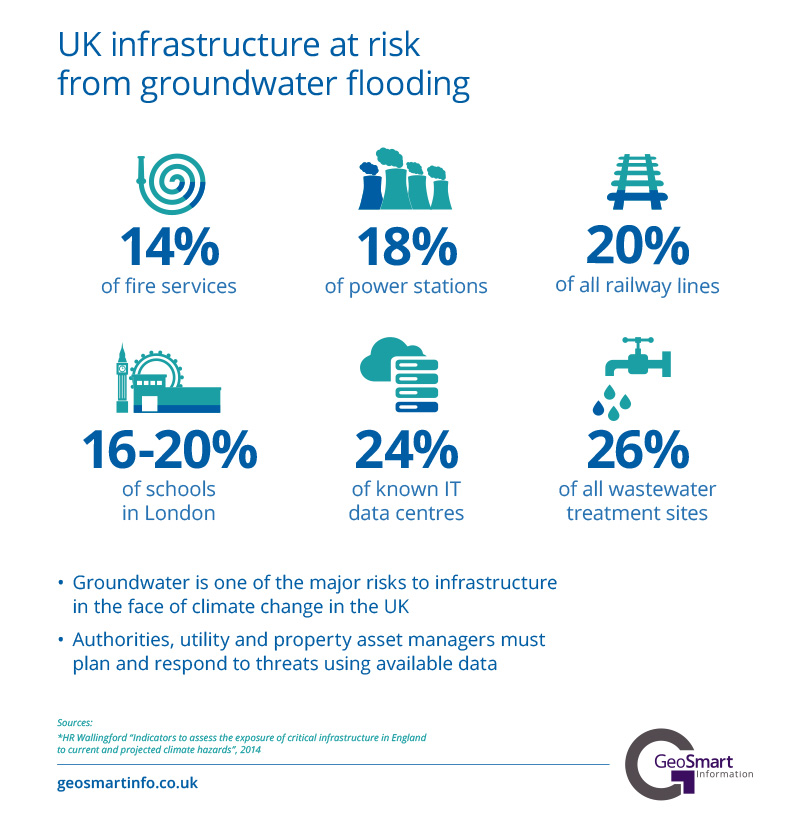Groundwater flooding and infrastructure – up to a 1/4 of critical sites at risk
Last week, we revealed the hidden cost of groundwater to the English economy in terms of damage to property – some £530million a year.
Groundwater flooding impacts an estimated 424,000 properties, many of them who are households unaware of the risk. This week we look at how it could affect the wider population by disrupting critical infrastructure.
According to the government commissioned HR Wallingford study in 2014 – the headlines are stark and can be explained by our latest infographic:
Natural hazards already account for 10-35% of all delays or service interruptions to electricity, road and rail customers every year.
Our road network is so sensitive to the smallest of delays and gridlock can spread quickly. Major routes in the south of England, vital as a trade corridor to continental Europe, are the Achilles heel of our network. Sinkholes in vulnerable areas, such as across chalk aquifers, have also opened up between carriageways, such as on the M2 in Kent.
The action of groundwater flowing through made ground from old quarries as well as undermining soluble rocks have been well documented by the media. All lead to delays and congestion on the roads, as well as health and safety risks from buildings, subsurface utilities and public spaces in jeopardy.
Climate projections suggest that the number of assets in high risk flood areas will increase by at least 50% by the 2050s.
At the same time, recognising the need to cater for dramatic population growth, the Government unveiled a huge £23billion boost to its infrastructure programme in the recent Autumn Statement. This is all well and good, but capital works on major transport and energy resilience projects must account for the massive hidden threat from groundwater flooding.
The infographic shows how many of our critical infrastructure supporting health, education, energy and civil protection is at risk from regular groundwater flood action.
The major assumption is that flooding from rivers causes the damage but it is groundwater that provides the catalyst for lengthy flooding. There is significant cost in terms of insurance risk and disruption to services and businesses – forcing many to curtail or suspend operation for the duration.
HR Wallingford reported that adverse weather was the third most frequent cause of disruption for UK companies, with 75% reporting to have been affected at some point over the past 12 months.
Data centres could be compromised – affecting cloud and internet based transactions, partially or totally depending on failover.
We have seen how the South West of England rail network has been cut off twice within two years due to flooding and how substations have been submerged, requiring the army to deploy emergency barriers to prevent further damage. But you can’t protect in the same way from groundwater flooding. It will find a way through floorboards and travel under surface barriers, so you need to design suitable mitigation and resilience to counter this unseen hazard. Information in the form of risk maps and live forecasts are available from GeoSmart to address these significant hazards for the first time on a national basis.
Better resilience and emergency planning is therefore critical to protect our critical infrastructure and business services.
The Met Office and Environment Agency jointly operate the National Flood Forecasting Centre and GeoSmart are proud to be supporting the pilot to test how groundwater alerts for up to 30 days in advance can help prepare property asset managers.
The report by the Climate Change Committee on Resilience stated that flooding in general created £1billion of damage every year on average. Our analysis suggests this figure could already be higher than that on average, given the impact of groundwater going largely un-modelled.
The risks will rise yet further as climate change leads to more intense rainfall, bringing flooding to places not currently in danger. The numbers of households at significant risk of flooding will almost double by 2050, if the global temperature rises by 4C.
See how GeoSmart is working with businesses and authorities through its groundwater flood forecasting services and national groundwater flood risk map. Or call us on 01743 298 100 or email enquiries@geosmartinfo.co.uk for more information.




